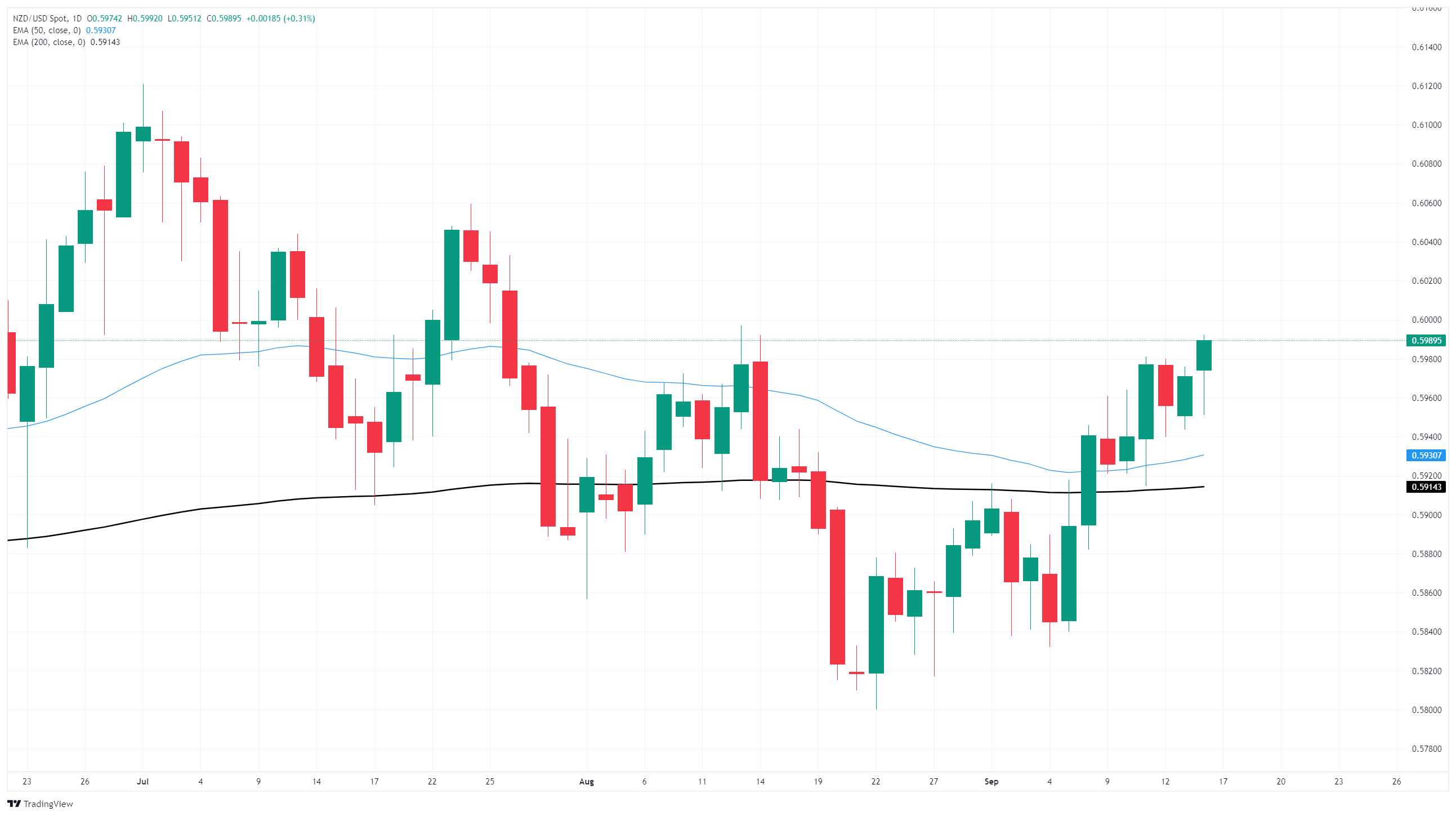NZD/USD breaks higher, inches toward 0.60
- NZD.USD broke through resistance to grind closer toward 0.6000 on Tuesday.
- The US Dollar is weakening across the board ahead of the Fed’s upcoming rate call on Wednesday.
- Teh Fed is widely expected to deliver the first of a volley of 25-bps rate cuts this week.
NZD/USD climbed through key technical resistance on Tuesday, chalking in another bullish candle and grinding closer toward the 0.6000 handle as the Greenback tumbles across the board. The Federal Reserve (Fed) is on deck for Wednesday, crimping global market flows as investors hunker down ahead of the key central bank outing.
A quarter-point interest rate cut from the Fed is widely anticipated this week, and markets have piled into short Greenback bets while the Fed deliberates. However, the key datapoint for markets will be the Federal Open Market Committee’s (FOMC) update to its Summary of Economic Projections, also known as the dot plot, which outlines policymakers’ own interest rate expectations. Three straight rate cuts through the rest of the year are baked into interest rate markets, and investors will be looking for the Fed to play ball.
New Zealand’s latest GDP figures, due on Thursday, are expected to show a quarterly contraction in NZ growth metrics. New Zealand’s second-quarter growth is expected to backslide by 0.3% QoQ, and contract by a slight 0.1% on the annualized figure.
NZD/USD price forecast
A key bullish break through a near-term technical ceiling has put the Kiwi on pace to reclaim the 0.6000 handle for the first time since July. The NZD has gained 3.3% since bottoming out at the 0.5800 level in August, but a long-run pattern of lower highs still threatens to cap gains for NZD/USD.
NZD/USD daily chart

New Zealand Dollar FAQs
The New Zealand Dollar (NZD), also known as the Kiwi, is a well-known traded currency among investors. Its value is broadly determined by the health of the New Zealand economy and the country’s central bank policy. Still, there are some unique particularities that also can make NZD move. The performance of the Chinese economy tends to move the Kiwi because China is New Zealand’s biggest trading partner. Bad news for the Chinese economy likely means less New Zealand exports to the country, hitting the economy and thus its currency. Another factor moving NZD is dairy prices as the dairy industry is New Zealand’s main export. High dairy prices boost export income, contributing positively to the economy and thus to the NZD.
The Reserve Bank of New Zealand (RBNZ) aims to achieve and maintain an inflation rate between 1% and 3% over the medium term, with a focus to keep it near the 2% mid-point. To this end, the bank sets an appropriate level of interest rates. When inflation is too high, the RBNZ will increase interest rates to cool the economy, but the move will also make bond yields higher, increasing investors’ appeal to invest in the country and thus boosting NZD. On the contrary, lower interest rates tend to weaken NZD. The so-called rate differential, or how rates in New Zealand are or are expected to be compared to the ones set by the US Federal Reserve, can also play a key role in moving the NZD/USD pair.
Macroeconomic data releases in New Zealand are key to assess the state of the economy and can impact the New Zealand Dollar’s (NZD) valuation. A strong economy, based on high economic growth, low unemployment and high confidence is good for NZD. High economic growth attracts foreign investment and may encourage the Reserve Bank of New Zealand to increase interest rates, if this economic strength comes together with elevated inflation. Conversely, if economic data is weak, NZD is likely to depreciate.
The New Zealand Dollar (NZD) tends to strengthen during risk-on periods, or when investors perceive that broader market risks are low and are optimistic about growth. This tends to lead to a more favorable outlook for commodities and so-called ‘commodity currencies’ such as the Kiwi. Conversely, NZD tends to weaken at times of market turbulence or economic uncertainty as investors tend to sell higher-risk assets and flee to the more-stable safe havens.